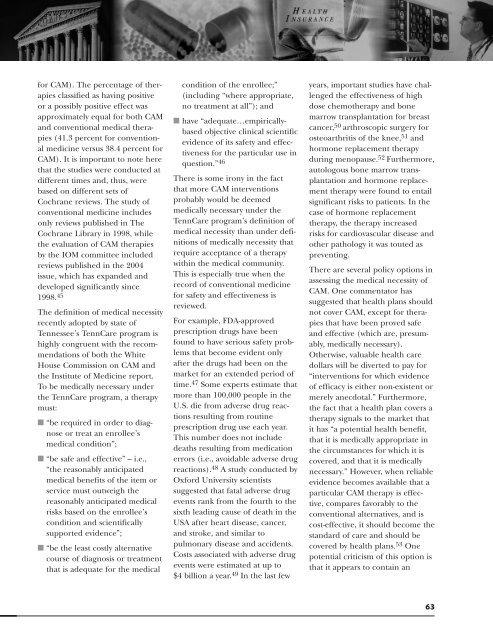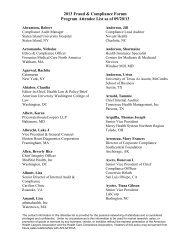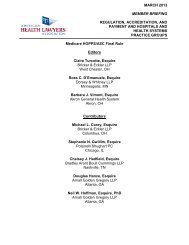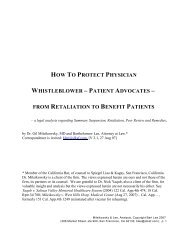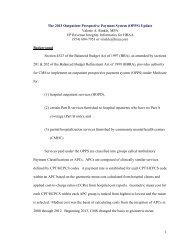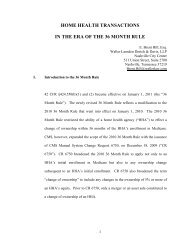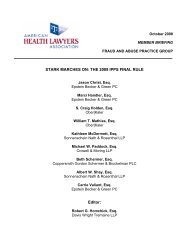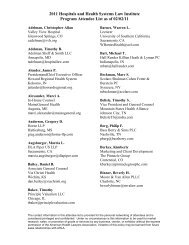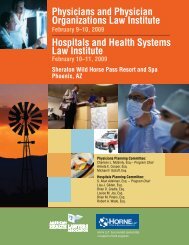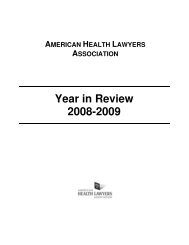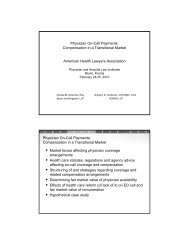Medical Necessity - American Health Lawyers Association
Medical Necessity - American Health Lawyers Association
Medical Necessity - American Health Lawyers Association
Create successful ePaper yourself
Turn your PDF publications into a flip-book with our unique Google optimized e-Paper software.
for CAM). The percentage of therapies<br />
classified as having positive<br />
or a possibly positive effect was<br />
approximately equal for both CAM<br />
and conventional medical therapies<br />
(41.3 percent for conventional<br />
medicine versus 38.4 percent for<br />
CAM). It is important to note here<br />
that the studies were conducted at<br />
different times and, thus, were<br />
based on different sets of<br />
Cochrane reviews. The study of<br />
conventional medicine includes<br />
only reviews published in The<br />
Cochrane Library in 1998, while<br />
the evaluation of CAM therapies<br />
by the IOM committee included<br />
reviews published in the 2004<br />
issue, which has expanded and<br />
developed significantly since<br />
1998. 45<br />
The definition of medical necessity<br />
recently adopted by state of<br />
Tennessee’s TennCare program is<br />
highly congruent with the recommendations<br />
of both the White<br />
House Commission on CAM and<br />
the Institute of Medicine report.<br />
To be medically necessary under<br />
the TennCare program, a therapy<br />
must:<br />
■ “be required in order to diagnose<br />
or treat an enrollee’s<br />
medical condition”;<br />
■ “be safe and effective” – i.e.,<br />
“the reasonably anticipated<br />
medical benefits of the item or<br />
service must outweigh the<br />
reasonably anticipated medical<br />
risks based on the enrollee’s<br />
condition and scientifically<br />
supported evidence”;<br />
■ “be the least costly alternative<br />
course of diagnosis or treatment<br />
that is adequate for the medical<br />
condition of the enrollee;”<br />
(including “where appropriate,<br />
no treatment at all”); and<br />
■ have “adequate…empiricallybased<br />
objective clinical scientific<br />
evidence of its safety and effectiveness<br />
for the particular use in<br />
question.” 46<br />
There is some irony in the fact<br />
that more CAM interventions<br />
probably would be deemed<br />
medically necessary under the<br />
TennCare program’s definition of<br />
medical necessity than under definitions<br />
of medically necessity that<br />
require acceptance of a therapy<br />
within the medical community.<br />
This is especially true when the<br />
record of conventional medicine<br />
for safety and effectiveness is<br />
reviewed.<br />
For example, FDA-approved<br />
prescription drugs have been<br />
found to have serious safety problems<br />
that become evident only<br />
after the drugs had been on the<br />
market for an extended period of<br />
time. 47 Some experts estimate that<br />
more than 100,000 people in the<br />
U.S. die from adverse drug reactions<br />
resulting from routine<br />
prescription drug use each year.<br />
This number does not include<br />
deaths resulting from medication<br />
errors (i.e., avoidable adverse drug<br />
reactions). 48 A study conducted by<br />
Oxford University scientists<br />
suggested that fatal adverse drug<br />
events rank from the fourth to the<br />
sixth leading cause of death in the<br />
USA after heart disease, cancer,<br />
and stroke, and similar to<br />
pulmonary disease and accidents.<br />
Costs associated with adverse drug<br />
events were estimated at up to<br />
$4 billion a year. 49 In the last few<br />
years, important studies have challenged<br />
the effectiveness of high<br />
dose chemotherapy and bone<br />
marrow transplantation for breast<br />
cancer, 50 arthroscopic surgery for<br />
osteoarthritis of the knee, 51 and<br />
hormone replacement therapy<br />
during menopause. 52 Furthermore,<br />
autologous bone marrow transplantation<br />
and hormone replacement<br />
therapy were found to entail<br />
significant risks to patients. In the<br />
case of hormone replacement<br />
therapy, the therapy increased<br />
risks for cardiovascular disease and<br />
other pathology it was touted as<br />
preventing.<br />
There are several policy options in<br />
assessing the medical necessity of<br />
CAM. One commentator has<br />
suggested that health plans should<br />
not cover CAM, except for therapies<br />
that have been proved safe<br />
and effective (which are, presumably,<br />
medically necessary).<br />
Otherwise, valuable health care<br />
dollars will be diverted to pay for<br />
“interventions for which evidence<br />
of efficacy is either non-existent or<br />
merely anecdotal.” Furthermore,<br />
the fact that a health plan covers a<br />
therapy signals to the market that<br />
it has “a potential health benefit,<br />
that it is medically appropriate in<br />
the circumstances for which it is<br />
covered, and that it is medically<br />
necessary.” However, when reliable<br />
evidence becomes available that a<br />
particular CAM therapy is effective,<br />
compares favorably to the<br />
conventional alternatives, and is<br />
cost-effective, it should become the<br />
standard of care and should be<br />
covered by health plans. 53 One<br />
potential criticism of this option is<br />
that it appears to contain an<br />
63


